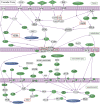Vascular tone pathway polymorphisms in relation to primary open-angle glaucoma
- PMID: 24603425
- PMCID: PMC4058608
- DOI: 10.1038/eye.2014.42
Vascular tone pathway polymorphisms in relation to primary open-angle glaucoma
Abstract
Aims: Vascular perfusion may be impaired in primary open-angle glaucoma (POAG); thus, we evaluated a panel of markers in vascular tone-regulating genes in relation to POAG.
Methods: We used Illumina 660W-Quad array genotype data and pooled P-values from 3108 POAG cases and 3430 controls from the combined National Eye Institute Glaucoma Human Genetics Collaboration consortium and Glaucoma Genes and Environment studies. Using information from previous literature and Kyoto Encyclopedia of Genes and Genomes (KEGG) pathways, we compiled single-nucleotide polymorphisms (SNPs) in 186 vascular tone-regulating genes. We used the 'Pathway Analysis by Randomization Incorporating Structure' analysis software, which performed 1000 permutations to compare the overall pathway and selected genes with comparable randomly generated pathways and genes in their association with POAG.
Results: The vascular tone pathway was not associated with POAG overall or POAG subtypes, defined by the type of visual field loss (early paracentral loss (n=224 cases) or only peripheral loss (n=993 cases)) (permuted P≥0.20). In gene-based analyses, eight were associated with POAG overall at permuted P<0.001: PRKAA1, CAV1, ITPR3, EDNRB, GNB2, DNM2, HFE, and MYL9. Notably, six of these eight (the first six listed) code for factors involved in the endothelial nitric oxide synthase activity, and three of these six (CAV1, ITPR3, and EDNRB) were also associated with early paracentral loss at P<0.001, whereas none of the six genes reached P<0.001 for peripheral loss only.
Discussion: Although the assembled vascular tone SNP set was not associated with POAG, genes that code for local factors involved in setting vascular tone were associated with POAG.
Figures


References
-
- Leske MC. Open-angle glaucoma—an epidemiologic overview. Ophthal Epidemiol. 2007;14 (4:166–172. - PubMed
-
- Flammer J, Pache M, Resink T. Vasospasm, its role in the pathogenesis of diseases with particular reference to the eye. Prog Retin Eye Res. 2001;20 (3:319–349. - PubMed
-
- Hayreh SS. Blood flow in the optic nerve head and factors that may influence it. Prog Retin Eye Res. 2001;20 (5:595–624. - PubMed
-
- Von Graefe A. Uber die iridectomie bei glaukom und uber den glaucomatosen prozess. Von Graefe's Arch Ophthalmol. 1857;3:456–555.
Publication types
MeSH terms
Substances
Grants and funding
- R01 EY011671/EY/NEI NIH HHS/United States
- U01 HG004446/HG/NHGRI NIH HHS/United States
- EY010886/EY/NEI NIH HHS/United States
- EY009847/EY/NEI NIH HHS/United States
- R01 EY015473/EY/NEI NIH HHS/United States
- EY009149/EY/NEI NIH HHS/United States
- R01 EY022306/EY/NEI NIH HHS/United States
- R01 EY013315/EY/NEI NIH HHS/United States
- EY144428/EY/NEI NIH HHS/United States
- U01 HG004728/HG/NHGRI NIH HHS/United States
- R01EY022746/EY/NEI NIH HHS/United States
- EY012118/EY/NEI NIH HHS/United States
- UL1 TR000427/TR/NCATS NIH HHS/United States
- R01 EY011008/EY/NEI NIH HHS/United States
- P01 CA087969/CA/NCI NIH HHS/United States
- EY18660/EY/NEI NIH HHS/United States
- EY015473/EY/NEI NIH HHS/United States
- U01 HG004424/HG/NHGRI NIH HHS/United States
- R01 HL073389/HL/NHLBI NIH HHS/United States
- EY011671/EY/NEI NIH HHS/United States
- CA49449/CA/NCI NIH HHS/United States
- EY13315/EY/NEI NIH HHS/United States
- HG005259-01/HG/NHGRI NIH HHS/United States
- EY015682/EY/NEI NIH HHS/United States
- R01 EY012118/EY/NEI NIH HHS/United States
- R01 EY015543/EY/NEI NIH HHS/United States
- R56 EY011671/EY/NEI NIH HHS/United States
- U01 HG006389/HG/NHGRI NIH HHS/United States
- R01 EY008208/EY/NEI NIH HHS/United States
- HG004608/HG/NHGRI NIH HHS/United States
- HG004728/HG/NHGRI NIH HHS/United States
- HHSN268200782096C/HG/NHGRI NIH HHS/United States
- EY013178/EY/NEI NIH HHS/United States
- UL1TR000427/TR/NCATS NIH HHS/United States
- R01 EY013178/EY/NEI NIH HHS/United States
- EY09611/EY/NEI NIH HHS/United States
- EY006827/EY/NEI NIH HHS/United States
- R01 EY019126/EY/NEI NIH HHS/United States
- R03 EY015682/EY/NEI NIH HHS/United States
- P01 CA87969/CA/NCI NIH HHS/United States
- R01 EY022305/EY/NEI NIH HHS/United States
- HG004446/HG/NHGRI NIH HHS/United States
- HL35464/HL/NHLBI NIH HHS/United States
- R01 EY009611/EY/NEI NIH HHS/United States
- R01 EY011405/EY/NEI NIH HHS/United States
- EY011008/EY/NEI NIH HHS/United States
- K02 DA021237/DA/NIDA NIH HHS/United States
- R21 EY022766/EY/NEI NIH HHS/United States
- UM1 CA167552/CA/NCI NIH HHS/United States
- R01 EY009580/EY/NEI NIH HHS/United States
- R01 HL035464/HL/NHLBI NIH HHS/United States
- UL1 RR025758/RR/NCRR NIH HHS/United States
- U10 EY012118/EY/NEI NIH HHS/United States
- R01 CA049449/CA/NCI NIH HHS/United States
- P30 EY014104/EY/NEI NIH HHS/United States
- R01 EY015872/EY/NEI NIH HHS/United States
- R01 EY009847/EY/NEI NIH HHS/United States
- R01 EY010886/EY/NEI NIH HHS/United States
- U01 CA049449/CA/NCI NIH HHS/United States
- HL073389/HL/NHLBI NIH HHS/United States
- EY09580/EY/NEI NIH HHS/United States
- HG004424/HG/NHGRI NIH HHS/United States
- 3R01EY019126-02S1/EY/NEI NIH HHS/United States
- EY015543/EY/NEI NIH HHS/United States
- EY008208/EY/NEI NIH HHS/United States
- U01 HG004608/HG/NHGRI NIH HHS/United States
- R01 EY022746/EY/NEI NIH HHS/United States
- R01 EY023512/EY/NEI NIH HHS/United States
- R01 EY018660/EY/NEI NIH HHS/United States
- U01HG006389/HG/NHGRI NIH HHS/United States
- EY144448/EY/NEI NIH HHS/United States
- 3R01EY015872-05S1/EY/NEI NIH HHS/United States
LinkOut - more resources
Full Text Sources
Other Literature Sources

